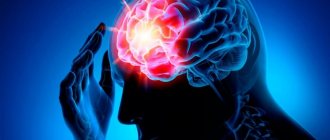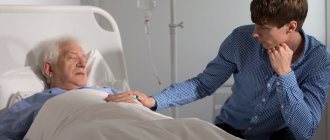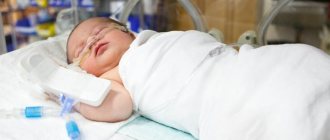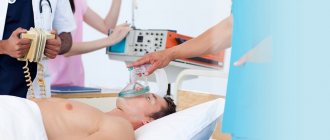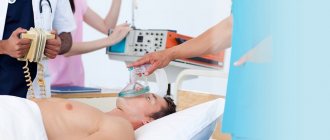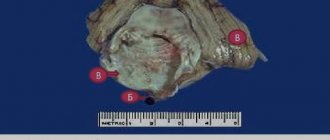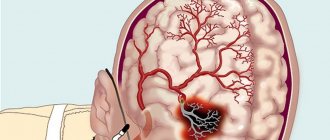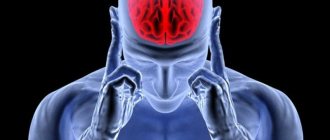A rapidly developing acute cerebrovascular accident is called a stroke. There are hemorrhagic and ischemic forms of the disease. The first is a lesion of a part of the brain resulting from a rupture of a vessel. Ischemic stroke is caused by a vascular blockage that interferes with blood flow. It also occurs due to prolonged spasm of the cerebral artery.
A stroke can occur in different hemispheres of the brain. Each of them is responsible for certain functions of the body. Therefore, a stroke of the left hemisphere has its differences from the right one. But in both cases, the patient faces complete or partial paralysis of the body. The disease develops according to the principle of “reverse symmetry”: with a stroke of the left hemisphere, the right side of the body is paralyzed, and with a right-sided lesion, the left side is paralyzed.
Functions of the left hemisphere
The mechanisms of logical thinking are concentrated in the left hemisphere of the brain. This brain side is dominant in some aspects of the body's functioning. She is responsible for:
- Processing of verbal information. It is thanks to the left hemisphere that people can recognize and control words, read and write. It is responsible for speech abilities. Also takes part in memorizing facts, dates and names.
- Analytical functions. The left side recognizes numbers and other mathematical symbols. Responsible for logic and the ability to analyze facts.
- Stage-by-stage processing of information. The left brain hemisphere allows you to analyze data sequentially.
- Mobility of the right side of the body. This area of the brain sends signals to the right limbs of the body.
- Literal understanding. In the left hemisphere, the literal perception of spoken and heard phrases and words occurs.
Expert opinion
Author: Andrey Igorevich Volkov
Neurologist, Candidate of Medical Sciences
Acute cerebrovascular accident occupies a leading position in the structure of mortality. This is associated with the risk of disease and the development of serious complications. An important role is played by the population’s untimely seeking of medical help. More than 60% of patients become disabled, 10% completely lose the ability to self-care. Left-sided stroke is diagnosed much more often. This is due to the presence of a characteristic clinical picture. Right-sided cerebrovascular accident is accompanied by nonspecific symptoms.
The main task of doctors is to quickly identify the type of disease, the extent of the pathological focus and its location. At the Yusupov Hospital, European CT and MRI units are used for this purpose. Thanks to modern medical equipment, rapid diagnosis is carried out and correct treatment is prescribed. Every minute you have a stroke can have irreversible consequences. Experienced neurologists at the Yusupov Hospital develop an individual treatment and rehabilitation plan. The length of hospital stay is determined by the severity of the condition. The prescribed drugs meet European quality and safety standards.
First aid for left-sided ischemic stroke
First of all, you should call and clearly explain to him what happened to the patient, list all the symptoms. After which, a team will come to you for transportation to the Yusupov Hospital, which will necessarily include a neurologist.
During the waiting period, it is necessary to provide first aid to the patient on your own. First aid for a stroke has basic rules that must be followed:
- the victim’s head should be raised 30 degrees, which can be achieved with the help of a low pillow, blanket, clothing, etc.;
- the patient must be provided with access to fresh air - it is necessary to open the windows and doors in the room;
- you need to loosen or remove all squeezing objects: belts, waistbands, collars, etc.;
- when vomiting, it is necessary to prevent the victim from choking on vomit by turning his head to the side, and then help him rinse his mouth;
- It is necessary to constantly monitor blood pressure, recording the results.
After transporting the patient to the hospital, the best neurologists at the Yusupov Hospital will conduct the necessary diagnostic tests and provide subsequent assistance - medicinal or surgical.
Which case is more dangerous: right-sided or left-sided?
Left-sided strokes are 57% more common than right-sided strokes. It has more pronounced symptoms, so it is easier to recognize. This allows you to consult a doctor in a timely manner and receive the necessary medical care. It is characterized by impaired speech and adequate thinking. However, unlike a right-sided stroke, a left-hemisphere stroke is more difficult to treat and brings more discomfort to the patient. In any case, rehabilitation after a cerebral hemorrhage requires a significant investment of time.
Clinical manifestations
Symptoms of hemorrhagic stroke are varied and are divided into two large groups: general cerebral and focal. Also, the symptoms strongly depend on the location of the hemorrhage, its size, the somatic condition of the patient and many other factors.
General cerebral symptoms of hemorrhagic stroke include the following:
- Impaired consciousness (stunning, stupor, coma). The larger the focus, the lower the level of consciousness. However, with damage to the brain stem, even a small focus of hemorrhage leads to severe depression of consciousness.
- Dizziness.
- Nausea, vomiting.
- Headache.
- General weakness.
- Breathing disorders.
- Hemodynamic disorders.
Predominantly focal symptoms include the following:
- Paresis or plegia in the limbs, hemiparesis is more common.
- Paresis of facial muscles.
- Speech disorders develop mainly with damage to the left temporal lobe.
- Visual impairment (including the development of anisocoria).
- Hearing impairment.
A stroke should be suspected if the patient has any type of speech impairment, weakness in the arm and leg on one side, the development of epileptic seizures without provoking factors (for example, such factors include alcohol consumption), impaired consciousness up to coma. In any suspicious cases, it is better to play it safe and call an ambulance. Behavior and assessment of the situation when a stroke is suspected should be considered in a separate article.
Causes of left hemisphere stroke
There are many different prerequisites for the development of left-sided stroke. Predisposing factors include:
- endogenous causes;
- exogenous factors.
The second category includes the patient's conditions and lifestyle. Endogenous causes are represented by the immunological characteristics of the body, heredity, age and gender of the person.
The most likely causes of the development of the disease on the left side of the brain are:
- diabetes;
- cardiovascular diseases;
- vein thrombosis;
- disorders of the blood composition and blood diseases that increase its viscosity;
- alcohol abuse, smoking;
- improper diet;
- uncontrolled use of hormonal, vascular and contraceptive drugs;
- frequent dizziness and migraines;
- osteochondrosis of the cervical spine;
- obesity;
- vegetative-vascular dystonia;
- sedentary lifestyle, insufficient physical activity
What is a stroke?
The disease is an acute circulatory disorder in the human brain. The attack develops rapidly. It takes from a few minutes to several hours for a person to be seriously injured - sometimes irreversibly. Doctors call the limit of providing effective assistance a time period of 6 hours. After this, the patient will no longer be able to recover if he survives. The consequences of a stroke are the death of brain cells due to oxygen starvation.
The two most common types of stroke are:
- By ischemic type (ischemic) – occupies a share of 75%. The peculiarity of this pathology is blockage of blood vessels or their compression. Damage occurs as a result of the presence of embolism, thrombosis and some other pathologies of the blood, blood vessels, and heart. Mortality rate is up to 15%.
- By hemorrhagic type (hemorrhagic) - occurs in 20-25% of cases. In this type of stroke, blood vessels rupture and bleeding occurs in the brain. Mortality rate – up to 35%.
Very rarely (up to 7% of cases) subarachnoid hemorrhage occurs. Its causes are traumatic brain injury or rupture of an arterial aneurysm (also due to trauma to the patient). In this case, the hemorrhage is directed into the space between the soft and arachnoid membranes of the brain. As a result of such a “blow”, more than half of the victims die.
You can undergo an examination in our clinic at the address: St. Petersburg, st. Bolshaya Raznochinnaya, 27 metro station Chkalovskaya
Features and symptoms
Vascular cerebrovascular accident on the left side has both general and specific manifestations. Wernicke's center and Broca's center are located in the left hemisphere cortex, so during a stroke, patients are partially or completely deprived of the ability to speak. They are also temporarily unable to think and reason logically. In addition, inhibited reactions to what is happening around are characteristic. If there is a lesion in the temporal lobe on the left side, the patient’s emotional background is also disturbed. It is possible to develop depression and a depressed state.
Common symptoms of a left hemisphere stroke include:
- severe and sharp headache (often accompanied by sound and photophobia);
- impairment of consciousness and coordination of movements;
- nausea, vomiting;
- blood pressure surges;
- pain in the chest.
The disease develops quite rapidly within a few hours. Poor circulation in the left hemisphere of the brain leads to convulsions, short-term amnesia, and partial or complete paralysis of the right side of the body. Patients also experience a skewed smile, as the right corner of the mouth droops downwards.
Possible consequences
Sagging muscles on the right side of the body, slurred speech or its complete absence, convulsive twitching and difficulties in articulation, difficulties or partial memory loss, difficulties in analyzing the situation, difficulty in perceiving any new information, inadequate perception of what is heard, a depressive state - all this is felt by people, survivors of left-sided ischemic stroke. Not all of the consequences are listed. Despite the fact that the process of treatment and recovery after a stroke is always long and tedious, there is a chance to regain your previous abilities. The main thing is to provide timely assistance to the victim.
Clinical Brain Institute Rating: 4/5 — 16 votes
Share article on social networks
Diagnosis and differential diagnosis
In order to reduce the consequences of a stroke on the left side of the brain, it is necessary to immediately provide medical assistance to the victim. Fortunately, the disease can be diagnosed fairly quickly.
Prehospital diagnostics
Any delay in identifying and treating a cerebral hemorrhage can lead to serious damage to its areas and even death of the patient. Manifestations of the disease can be detected before going to the clinic. It has the following early signs:
- semi-fainting state of the patient;
- skewed face to one side;
- unnatural, forced smile;
- loss of balance, poor coordination of movements;
- illogical, difficult speech.
A person experiencing a left-sided stroke experiences a headache and may see double. The presence of even one symptom that does not go away for a long time is a serious reason to call an ambulance.
Instrumental diagnostics
When a patient with a stroke of the left hemisphere is taken to the hospital, the doctor conducts a full examination, which also includes instrumental diagnostics. It allows you to determine the scale of hemorrhage, localize the source of damage and determine the form of stroke. During hardware diagnostics the following is carried out:
- MRI of the brain.
- Computed tomography.
- ECG.
- EchoCG.
In cases where emergency neuroimaging is not possible, a lumbar puncture is performed. This procedure is preceded by an Echo-EG. Performed in order to determine or eliminate displacements of the middle structures. If they are present, lumbar puncture is contraindicated.
The doctor also prescribes a clinical blood test, which is necessary to accurately determine the platelet count. A biochemical analysis is required to determine the level of sugar in the blood.
Differential diagnosis of various types of stroke
One of the diagnostic tasks is to differentiate vascular rupture from other diseases with similar symptoms. Once an accurate diagnosis has been made, the next goal of examining a patient with a left hemisphere stroke is to determine the form of the disease. This is a key point for subsequent therapy.
In the course of differential diagnosis, specialists rely on a combination of various signs characteristic of ischemic or hemorrhagic stroke.
Meningeal symptoms
They appear when there is damage to the meninges, which includes a stroke of the left hemisphere. This group of manifestations includes:
- Brudzinski's sign. There are upper and lower. In the first case, a study of the rigidity of the neck muscles is carried out. The chin approaches the chest, causing the lower limbs and knee joints to involuntarily bend. During a lower examination, pressing on the solar plexus causes the same reaction.
- Kernig's sign. The patient lies on his back, and the doctor bends his leg at the hip joint at an angle of 90 degrees, after which he tries to straighten it at the knee. If this symptom is present, the muscles will involuntarily contract, which will prevent the knee from straightening.
Diagnosis, treatment, consequences
To diagnose AI at home, just do a few tests:
Advertising:
- You need to smile and stick out your tongue a little. If pathology is present, a left- or right-sided skew is noted.
- Raise your hands up. If there is an illness, then this becomes difficult to do.
- You need to provide your full name, date of birth and address. The sick person may not remember this. Speech will also be slurred.
How is the disease diagnosed in the clinic?
AI is an emergency condition, so if one of the signs is present, you must immediately call an ambulance or take the patient to a specialist!
At the clinic, the doctor conducts a thorough examination. First of all, an anamnesis is collected, that is, relatives are interviewed about the manifestation of symptoms, possible causes, etc. Next, the doctor collects laboratory tests (blood and urine). Then a physical examination is carried out (tests, etc., which indicate disorders in the heart, respiratory tract, genitourinary organs, brain). And only after this an instrumental examination is used. This can be computed tomography (CT) or magnetic resonance imaging (MRI).
Intestinal adhesions are pathological “sticking” formations that arise between various organs located in the abdominal cavity and provoke “soldering” of their walls together. Read more in the article: “symptoms of intestinal adhesive disease.”
Treatment methods
The main goal of therapy is aimed at restoring functionality and preventing the development of complications, and they can be the most unpredictable.
Standard treatment is based on the following measures:
- Normalization of respiratory functions. To do this, the doctor may suggest a tracheotomy, connection to a mechanical ventilation and sanitation.
- Normalization of the activity of the heart and blood vessels. First of all, it regulates blood pressure. The doctor prescribes antioxidants, glycosides or antiarrhythmic drugs.
- Restoration of water, salt, acid and alkaline balance.
- It is important to protect brain structures through neuroprotection.
- Elimination of symptoms with medications.
- Prevention of bedsores.
What consequences may there be
What consequences can there be, how long do people live with an ischemic stroke on the right or left side? This question is the most popular, since every person cares about his own life. You need to know that this depends on the severity and type of disease.
In general, the consequences can be as follows:
Advertising:
| Type of complication | Description of the complication |
| Mental disorder | The patient may develop a depressive state, as there is a fear that the person may become a burden to relatives. Most often, aggression, fearfulness, disorientation and frequent, sudden changes in mood are observed. |
| Impaired sensitivity | The limbs and facial area are affected. It takes a long time to restore the limbs, since the nerve fibers that are responsible for sensitivity take longer to regenerate than the motor fibers. |
| Deviations of motor functions | The patient feels severe weakness in the lower and upper extremities, up to the inability to move independently and do any work. |
| Cognitive impairment | Memory loss, partially or completely. The patient may also underestimate the complexity of situations and become disoriented in time and location. The behavior may resemble that of a small child. |
| Speech | Incoherence of speech, inability to express thoughts and pronounce words. |
| Swallowing functions | Swallowing becomes difficult, which can cause the patient to choke on solid or even liquid food. This leads to aspiration pneumonia, which threatens human life. |
| Coordination of movements | Staggering when moving, dizziness. As a result, a person may fall during a sudden movement. |
| Epilepsy | Almost 10% experience epileptic seizures. |
Treatment of left hemisphere stroke
Impaired blood circulation in the brain leads to serious consequences. To level them out, treatment of a stroke on the left side must be immediate. Prompt assistance will allow you to correctly diagnose and correctly draw up a step-by-step and comprehensive treatment plan.
First aid to a patient
Before doctors arrive, the patient must be given first aid. This will help improve his condition a little. First aid consists of a number of simple actions that the victim’s relatives can perform:
- The patient should be placed on a surface covered with pillows and his head should be raised.
- The patient may have difficulty breathing, so it is necessary to open the windows.
- It is also necessary to rid the person of tight and constricting clothing: unbutton the shirt collar, remove the belt, take off a jacket with a tight neck.
- If there is vomiting, carefully and carefully turn the patient's head to the side. This position will prevent vomit from entering the respiratory tract.
Until the ambulance arrives, you need to stay close to the stroke survivor. He may be in a panic, so you need to try to calm him down.
Drug therapy
In clinical settings, physicians' efforts are aimed at minimizing nerve and muscle damage. The main goal of therapy is to preserve the functionality of the brain and cardiovascular system. The patient is prescribed drugs that restore blood circulation.
Drug treatment is selected according to the form of the disease. Drugs for left hemisphere stroke of ischemic nature include the following groups:
- Thrombolytics. They are used in the first hours after a vascular accident to dissolve blood clots.
- Anticoagulants.
- Medicines that lower blood pressure.
- Neuroprotectors.
- Vasoactive drugs.
In the case of hemorrhagic stroke on the left side, vascular strengthening drugs and drugs that prevent vasospasm are used.
For both types, general medications are also provided, which include diuretics and decongestants, as well as sedatives and hypnotics. During rehabilitation, patients are also prescribed medications to treat bedsores.
Surgery
Surgery is most often necessary for hemorrhagic stroke of the left hemisphere of the brain. Surgical treatment is aimed at removing the intracerebral hematoma. The need for surgery is determined taking into account the following factors:
- general condition of the patient;
- volume of the lesion;
- localization of hemorrhage.
Surgery is indicated only in extremely severe cases when the patient's life is in danger. There are also cases when the hematoma is not removed immediately after a stroke, but during rehabilitation.
As a rule, surgical treatment is used for patients whose hematoma size is more than 50 ml. The operation is also indicated for patients with cerebellar damage.
Coma due to hemorrhagic stroke
Approximately 90% of patients with GI in a state of stupor or coma die in the first five days, despite intensive therapy. Disorders of consciousness are characteristic of many pathologies, manifested by inhibition of the functions of the reticular formation of the brain.
Brain dysfunctions develop under the influence of:
- Endo- and exotoxins – derivatives of the end products of metabolism;
- Oxygen and energy starvation of the brain;
- Metabolic disorders in brain structures;
- Expansion of the volume of brain matter.
The most important factors in the development of coma are acidosis, cerebral edema, increased intracranial pressure, and impaired microcirculation of brain fluids and blood.
The state of coma affects the functioning of the respiratory system, excretion (kidneys) and digestion (liver, intestines). It is impossible to recover from a coma at home, and it is very difficult even in intensive care conditions.
The clinical definition of coma is carried out using the GCS (Glasgow Coma Scale), and some other methods that are important for clinicians are used. There are precoma and four stages of coma. The easiest is the first, and the hopeless state of the patient corresponds to the fourth stage of coma.
Rehabilitation after a stroke of the left hemisphere
The process of restoring functions lost after a stroke must be comprehensive and versatile. Brain damage entails a number of physiological and mental disorders. Rehabilitation measures are selected depending on the general condition of the patient. This is a long and difficult journey that the patient’s loved ones go through together. Help and support for a person who has suffered a stroke on the left side of the brain is of great importance. He needs constant care, which also implies strict adherence to all the doctor’s recommendations and instructions.
The following methods have shown good results in recovery after a stroke:
- physiotherapy;
- massage and manual therapy;
- physiotherapy.
Psychologists and speech therapists also work with the patient to help restore lost speech functions and stabilize the patient’s emotional state.
Massage, manual therapy and passive exercises
After the main threats to a person’s life and health after a stroke of the left hemisphere have been eliminated, the doctor prescribes a series of treatment and rehabilitation procedures. Most patients are indicated for massage and manual therapy. Due to the effect on certain receptor zones, the body’s functioning is stimulated. The most commonly used is acupressure. The specialist presses on certain areas on the patient’s body, thereby improving the mobility of the limbs. Also, such manipulations help blood circulation, helping to thin it.
One of the consequences of a severe stroke on the left side is partial or complete paralysis of the right limbs. Due to limited joint mobility, contractures may occur. You can prevent them with the help of massage and passive gymnastics. This is a set of exercises aimed at:
- relieving excessively high muscle tone during paralysis;
- return of precision and clarity to movements;
- increased blood supply to tissues;
- prevention of bedsores.
Keeping the patient moving is very important, since it is long-term immobility that leads to many complications.
Therapeutic exercises
To restore the motor function of the right side of the body after a left-sided stroke, physical therapy is prescribed. The main goal of health-improving gymnastics is to develop movements and improve the sensitivity of the limbs.
These are simple exercises that the patient needs to perform several times a day with a certain number of approaches. They are presented:
- clenching and unclenching your palm into a fist;
- raising your hand up in front of you and slowly lowering it;
- lifting your leg up from a lying position.
More complex gymnastics are performed together with a specialist.
Patients are also prescribed a number of breathing exercises that help get rid of shortness of breath and improve the functioning of the heart and blood vessels.
Physiotherapy
This rehabilitation method is used for both ischemic and hemorrhagic strokes of the left hemisphere of the brain. The type of procedures, their number, frequency and duration are determined by a specialist. When developing physical therapy tactics, the individual indications of the patient and the degree of acquired disorders are taken into account.
The main rehabilitation measures are:
- magnetic therapy;
- acupuncture;
- vibration therapy;
- electrophoresis;
- laser exposure;
- ultrasound treatment.
The procedures are aimed at:
- reduction of pain syndrome;
- increasing immunity;
- improvement of lymph and blood flow;
- prevention of blood clots;
- decreased blood pressure;
- normalization of vascular tone;
- preventing recurrent stroke;
- relief from hypertonicity and muscle spasticity.
A vascular accident in the brain radically changes a person’s life. Even after undergoing rehabilitation, when lost motor and speech abilities are restored, many patients cannot fully return to their usual rhythm. This is because some brain damage is irreversible, especially in old age. In addition, there is a fairly high probability of another stroke. To prevent this from happening, the patient needs to reconsider his attitude towards life and make fundamental changes in its course. In other words, he should try to improve its quality, first of all by giving up bad habits:
- smoking;
- alcohol abuse;
- uncontrolled use of certain medications.
A sedentary lifestyle often leads to strokes of the left hemisphere of the brain. People with sedentary work and no active recreation are at risk. After the patient has overcome the consequences of a cerebral hemorrhage, he needs to walk more often and more, play sports and properly alternate activity with rest.
A person after a stroke must be protected from stress and unnecessary worries. You also need to relieve him of the stress of work. Relatives and friends will have to take on most of the household responsibilities for the first year after illness. This is especially true for those that require heavy lifting or involve standing on your feet for a long time.
Treatment
Stroke therapy in the acute period may include:
- Pain relief, correction of body temperature (paracetamol, efferalgan, naproxen, diclofenac, often opiates, propafol). Aspizol, dantrolene are given intravenously, and magnesium sulfate is given by drip.
- Reducing blood pressure, which helps stop bleeding in the brain. For this purpose, drugs are administered intravenously: labetalol, nicardipine, esmolol, hydralazine. However, a sharp decrease in pressure in the first days is not allowed. Next, tablet drugs are prescribed - captopril, enalapril, capoten (as basic therapy orally or through a tube).
- Diuretics for persistent high blood pressure (chlorothiazide, andapamide, Lasix), calcium antagonists (nimotop, nifedipine).
- In case of severe hypotension, vasopressors are prescribed by drip (norepinephrine, mesaton, dopamine).
- Often, a continuous intravenous infusion is used to administer the above drugs, monitoring the pressure level every 15 minutes.
- To reduce cerebral edema, dexamethasone is recommended for 3 days (intravenously). If the swelling progresses, glycerin, mannitol, albumin, and refortan are injected dripwise.
- Often, a continuous intravenous infusion is used to administer the above drugs, monitoring the pressure level every 15 minutes.
- Drugs for the correction of neurological symptoms (sedatives - diazepam, muscle relaxants - vecuronium).
- Local therapy is aimed at eliminating bedsores and includes treating the skin with camphor alcohol and sprinkling with talcum powder.
- Symptomatic therapy - anticonvulsants (lorazepam, thiopental or anesthesia for 1-2 hours), medications for vomiting and nausea (metoclopramide, torecan), against psychomotor agitation (haloperidol). For pneumonia and urological infections, a course of antibacterial treatment is carried out.
In the presence of large hematomas (more than 50 ml), surgical intervention is performed. Excision of the hemorrhage site can be carried out if it is localized in an accessible part of the brain, and also if the patient is not in a comatose state. Most often, clipping of the aneurysm neck, puncture-aspiration elimination of the hematoma, its direct removal, as well as ventricular drainage are used.
Prognosis for treatment of left hemisphere stroke
Stroke is a dangerous and complex disease. Unfortunately, no doctor can give an accurate prognosis regarding the patient’s recovery. The success of rehabilitation primarily depends on the timeliness of assistance and initiation of treatment.
Regarding the duration of the recovery period, the following factors must be taken into account:
- size of the lesion;
- presence of emotional disorders;
- the age of the person who experienced a left-sided stroke - the older the patient, the more difficult it is for him to recover;
- deterioration of mental abilities;
- localization of the lesion.
The intensity of stroke development is also of great importance. With a favorable course of the disease, when the patient regains consciousness after a few minutes or hours, the likelihood of complete restoration of lost functions is quite high. The compressed development of the disease is more dangerous, as there is a risk of repeated vascular rupture. However, in this case, most of the functions are restored. A progressively severe variant of the development of the disease is characterized by the fact that a person comes to his senses more than three days after the stroke. In this situation, symptoms rapidly increase and there is a high chance that the patient will receive lifelong disability.
The prognosis for life after treatment for a left hemisphere stroke is individual for each person. However, timely treatment, compliance with doctor’s recommendations, a healthy lifestyle, as well as a reduction in emotional distress help speed up the recovery process.
How long do they live after a hemorrhagic stroke?
The prognosis of hemorrhagic stroke is unfavorable. It depends on the location and extent of the lesion. Hemorrhage into the brainstem is dangerous, which is accompanied by respiratory failure and a sharp, poorly corrected by drugs, decrease in blood pressure to critical levels. Hemorrhage into the ventricles with their breakthrough is severe and often ends in death.
How long do people live with hemorrhagic stroke? This pathology is fatal in 50-90% of cases. Death may occur on the very first day - against the background of generalized convulsions, when breathing is impaired. More often, death occurs later, by 2 weeks. This is due to a cascade of biochemical reactions triggered by the outpouring of blood into the cranial cavity and leading to the death of brain cells. If there is no displacement of the brain, no herniation (entry into a bone hole), no breakthrough of blood into the ventricles, and the compensatory capabilities of the brain are sufficiently large (this is more typical for children and young people), then the person has a great chance of survival.
At 1-2 weeks, in addition to neurological disorders, complications associated with the immobility of the patient, exacerbation of his chronic diseases or connecting him to an artificial respiration apparatus (pneumonia, bedsores, liver, kidney, cardiovascular failure) occur. And if they do not lead to death, then by the end of 2-3 weeks the cerebral edema will stop. By week 3, it becomes clear what the consequences of a hemorrhagic stroke are in this case.
Prevention
The basis for preventing left-sided stroke is lifestyle correction. To avoid experiencing the consequences of this serious disease, you need to:
- Watch your weight. Excess weight leads to increased blood pressure and provokes cardiovascular diseases.
- Avoid fatty foods and moderate your intake of foods of animal origin. Add more vegetables and fruits to your diet.
- Quit smoking. Cigarettes have a destructive effect on blood vessels, constricting them and preventing normal blood circulation.
- Exercise regularly and go for walks. Physical activity reduces the risk of developing vascular diseases.
- Drink moderate amounts of alcohol. A complete abstinence from alcoholic beverages is not necessary, although it is best to discuss whether you can drink alcohol with your doctor.
How to protect yourself from an attack
To avoid becoming a victim of a stroke, you should adhere to the following simple preventive measures. Firstly, treat any diseases of the cardiovascular system in a timely manner. When they become chronic, undergo regular preventive examinations.
Secondly, lead a healthy lifestyle, spend as much time as possible in the fresh air to avoid the development of oxygen starvation. Thirdly, engage in light and easy sports, such as playing tennis, running, and gymnastics. This will help improve metabolic processes in the body, avoid congestion and saturate the tissues with oxygen.
Carefully monitor your diet, avoid eating fatty, smoked, salty foods, as well as foods that provoke the accumulation of cholesterol in the blood. If you tend to be overweight, carefully monitor your weight to prevent obesity.
Carefully take care of the occurrence of traumatic brain injuries, protect your head when performing construction work or riding a bicycle. Give up bad habits such as alcohol and smoking. If your health deteriorates, do not self-medicate, since arbitrary intake of medications can contribute to the occurrence of disturbances in the functioning of the cardiovascular system.
Try to avoid stress and nervous tension. If you cannot cope with the situation on your own, then you need to contact a psychologist or psychotherapist. Maintain a daily routine. You should sleep at least 8 hours, preferably going to bed and waking up at the same time. A good habit would be to attend massage sessions and acupuncture. Such preventive measures will help maintain health and prevent stroke.
By regularly following the above recommendations, you can not only protect yourself from stroke, but also improve your overall health, which will have a positive impact on the functioning of all body systems.
Paralysis of the left side of the body due to a stroke is not a death sentence. It is important to provide first aid to the patient as soon as possible, and then carefully follow all the instructions of the attending physician. Then, with a high degree of probability, the patient will be able to restore lost functions and return to their usual way of life.
Who can have a stroke? Predisposing factors
It is generally accepted that stroke occurs only in older people. However, in recent decades the disease has been rapidly becoming younger. An attack can occur as early as 40 years of age or even earlier.
Main risk factors:
- disturbances in sleep and nutrition when entering a “dangerous” age – over 50 years;
- hypertension;
- chronic heart disease;
- high stress loads at work;
- smoking and alcohol abuse;
- temporary, rapidly passing ischemic attacks;
- high blood cholesterol levels;
- obesity;
- diabetes mellitus (it increases the likelihood of not only the first, but also a second stroke);
- hereditary factor;
- lack of timely hospitalization during an attack and lack of qualified medical care in municipal hospitals;
- trauma (the rarest cause of stroke)
However, symptoms and causes differ between women and men.
The main distinguishing features of female attacks:
- the predominance of the disease is of the hemorrhagic type;
- very long and difficult recovery of functions;
- high mortality;
- high loads on blood vessels during pregnancy;
- Among the main causes are migraines, headaches, and great stress;
- it’s easier to see the first symptoms of an approaching “blow”;
- One of the provoking factors is taking oral contraceptives.
The most pronounced symptoms in women include: weakness, slowness of movement, shortness of breath, wheezing, increased heart rate, blurred vision, double vision, fainting, impaired hearing, pain on one side of the face and body, and unbearable headache.
In men
The main risk factors are impaired blood circulation, blockage of blood vessels, rupture of arteries with subsequent hemorrhage, blood thickening due to various diseases, obesity, diabetes mellitus, lack of physical activity, poor diet and eating disorders, bad habits, severe physical activity, vegetative-vascular dystonia, hypertension .
The main signs of a stroke in men may appear periodically, but go away over time. In this situation, the most dangerous thing is to decide that the trouble is over. After all, most likely, these are just transient ischemic attacks, signaling the approach of a stroke.
With the ischemic type, a man may feel dizziness, severe headache (it cannot be relieved by painkillers), weakness, decreased sensitivity in the limbs and numbness, short-term fainting, and vomiting.
A hemorrhagic attack is expressed by loss of consciousness, a sharp increase in pressure, the face becomes very red, noises are heard when breathing, facial asymmetry is noticeable, and vomiting occurs.
Dangerous consequences
According to statistics, approximately 10% of patients who have suffered an acute disorder of cerebral circulation on the left side recover completely. The remaining survivors are diagnosed with persistent consequences of the disease. They affect a person’s quality of life and social opportunities. It is difficult to say which stroke is more dangerous - right-sided or left-sided. Different localization of the problem has its own nuances both in the acute period and in the post-stroke period.
Dangerous consequences:
- Persistence of hemiparesis. Despite the efforts made during the rehabilitation period, the muscles on the affected side do not always return to normal tone. The limbs remain completely or partially paralyzed. In addition to motor dysfunction, sensory disorders also remain on the affected side.
- Speech disorders. Their severity can range from complete loss of the ability to speak to minor articulation disorders. Often the patient gets confused in words, misinterprets their meaning, and does not understand what is said and heard.
- Writing disorders. In addition to problems with oral speech, patients may have difficulty writing text.
- Loss of self-care skills. Disability and need for care are common consequences of cerebral circulation problems.
- Loss of logical thinking. Left-sided brain lesions negatively affect the ability to make logical conclusions. Patients in the post-stroke period partially or completely lose the ability to adequately and logically assess the world around them.
- Emotional lability. Causeless fun or depression are symptoms that occur during the rehabilitation period. Apathy can become a serious obstacle when carrying out restorative procedures, since the patient does not want to do anything on his own.
